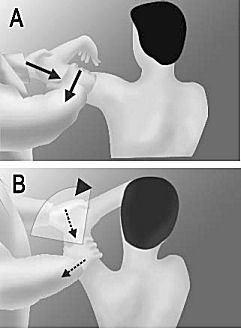Kim test: Difference between revisions
Evan Thomas (talk | contribs) mNo edit summary |
(added categories) |
||
| Line 33: | Line 33: | ||
<references /> | <references /> | ||
[[Category:Assessment]] [[Category:Shoulder]] [[Category:Special_Tests]] [[Category:Shoulder Special Tests]] [[Category:Musculoskeletal/Orthopaedics]] [[Category:EIM_Residency_Project]] | [[Category:Assessment]] | ||
[[Category:Shoulder]] | |||
[[Category:Special_Tests]] | |||
[[Category:Shoulder Special Tests]] | |||
[[Category:Musculoskeletal/Orthopaedics]] | |||
[[Category:EIM_Residency_Project]] | |||
[[Category:Sports Medicine]] | |||
[[Category:Sports Injuries]] | |||
[[Category:Athlete Assessment]] | |||
Revision as of 20:31, 27 August 2018
Original Editor - Sarah McBride
Top Contributors - Admin, Sarah McBride, Kim Jackson, Tony Lowe, Dan Rhon, Clinically Relevant, Evan Thomas, Naomi O'Reilly, Kai A. Sigel, WikiSysop and Wanda van Niekerk
Purpose[edit | edit source]
Detection of a posteroinferior labral lesion.
Technique[edit | edit source]
A - With the patient in a sitting position with the arm 90 degrees of abduction, the examiner holds the elbow and lateral aspect of the proximal arm, and a strong axial loading force is applied.
B - while the arm is elevated 45 degrees diagonally upward, downward and backward force is applied to the proximal arm. A sudden onset of posterior shoulder pain indicates a positive test result, regardless of accompanying posterior clunk of the humeral head.

|
[1] |
Evidence[edit | edit source]
The sensitivity of the Kim test was 80%, specificity was 94%. The interexaminer reliability between 2 examiners was 0.91[2].
The accuracy of the jerk test in detecting a posteroinferior labral lesion was the following: sensitivity, 73%; specificity, 98%[2].
The Kim test was more sensitive in detecting a predominantly inferior labral lesion, whereas the jerk test was more sensitive in detecting a predominantly posterior labral lesion. The sensitivity in detecting a posteroinferior labral lesion increased to 97% when the 2 tests were combined[2].
References[edit | edit source]
- ↑ Physiotutors. Kim's Test | Posteroinferior Labrum Lesions. Available from: https://www.youtube.com/watch?v=-knsALCdv_A
- ↑ 2.0 2.1 2.2 1. SH Kim et al. A Novel Test for Posteroinferior Labral Lesion of the Shoulder—A Comparison to the Jerk Test Am J Sports Med - 01-AUG-2005; 33(8): 1188-92






